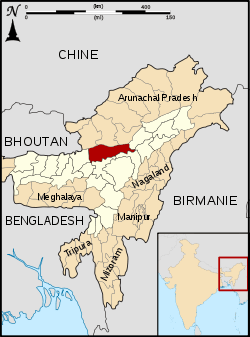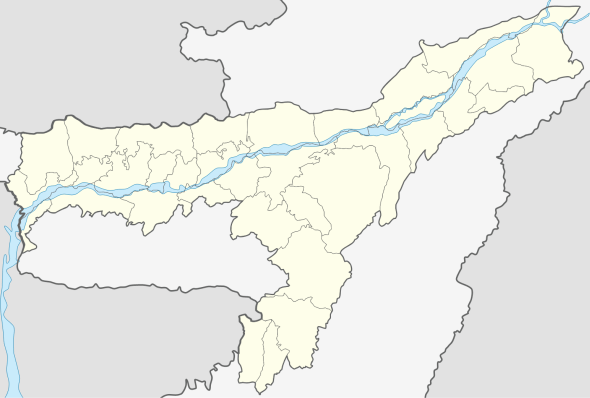Sonitpur district
| Sonitpur district | |
|---|---|
| District | |
 Map of Sonitpur district | |
 Sonitpur district  Sonitpur district | |
| Coordinates: 26°38′N 92°48′E / 26.63°N 92.8°ECoordinates: 26°38′N 92°48′E / 26.63°N 92.8°E | |
| Country |
|
| State | Assam |
| Division | North Assam |
| Headquarters | Tezpur |
| Area | |
| • Total | 5,324 km2 (2,056 sq mi) |
| Elevation | 48-560 m (−1,789 ft) |
| Population (2011) | |
| • Total | 1,925,975 |
| • Density | 360/km2 (940/sq mi) |
| Languages | |
| • Official | Assamese |
| Time zone | UTC+5:30 (IST) |
| ISO 3166 code | IN-AS |
| Vehicle registration | AS |
| Website |
sonitpur |
Sonitpur {Pron: ˌsə(ʊ)nɪtˈpʊə or ˌʃə(ʊ)nɪtˈpʊə} is an administrative district in the state of Assam in India. It stands among the largest districts of Assam. In terms of area Sonitpur is the second largest district of Assam after Karbi Anglong district. It is spread over an area of 5324 km2 on the northern banks of Brahmaputra, the lifeline of Assam. The population of Sonitpur district is 1,924,110 as per 2011 Census. It is the third most populous district of Assam (out of 27), after Nagaon and Dhubri.[1] The demography of Sonitpur district is not entirely homogenous as several linguistic, religious and ethnic communities and groups live in Sonitpur district. It is also home to several wildlife sanctuaries, and national parks. The district headquarters are located at Tezpur. Distance from State Capital (Dispur) is 198 km (via Nagaon) and 181 km (via Mangaldoi).
Etymology
The name Tezpur is derived from the Sanskrit words 'teja' (meaning blood) and 'pura' (meaning town or city). Legend has it that the original name of this place was 'Sonitpur' ('sonit' in Sanskrit also means blood), the capital of the asura king, Banasura, a devout of Shiva. Later his daughter Usha had a Gandharva marriage with Aniruddha, the grandson of Lord Krishna, whom she had abducted with the help of Chitralekha. On finding this Banasura imprisoned Aniruddha. Subsequently, in the battle between Krishna's army and Banasura's army fought for the rescue of Aniruddha, the grandson of Lord Krishna, according to legend, there was so much bloodshed that the whole place was stained in red.[2][3] This led to the name of the place becoming Tezpur. It is the "seventh largest city" of Assam after Guwahati, Silchar, Dibrugarh, Jorhat, Nagaon and Tinsukia.
History
Sonitpur district was created in 1983 when it was split from Darrang.[4] Udalguri was also carved out for the BTAD. Sonitpur district has a long history starting with Kamrupa Mlechha rule, which divided into Baro-Bhuyan rule and Chutiya kingdom rule. The border between the two kingdoms was the Kameng/Bharali river. Later, the Ahoms occupied the region during the period 1505-10 AD under the rule of Dihingia raja.
Administration
- Headquarter : Tezpur
- Number of Sub-Divisions : TEZPUR
- Number of Revenue Circles/ Tehsils : TEZPUR
- Number of Mouza : 26
- Number of Community Development(C.D.) Blocks : 17
- Number of Police Stations : 11
- No. of Anchalik Panchayats : 14
- Name of Gaon Panchayats : 158
- Number of Villages : 1615 (including 19 under BTAD)
- Number of Towns : 6
- Names of Towns : Tezpur, Dhekiajuli, Rangapara, Jamugurihat
- Number of Municipality Board: 2
- Number of Town Committees : 4
- Number of Police District : 2 (Sonitpur Police District & Biswanth Police District)
Geography
Sonitpur district occupies an area of 5,324 square kilometres (2,056 sq mi),[5] comparatively equivalent to Guadalcanal.[6] Major Rivers in the district are Brahmaputra, Jiabharali, Gabharu, Borgang & Buroi.
National protected area
Climate
Sonitpur District falls in the Tropical Rainforest climate region, (Af ) in Koppen's climate classification and enjoys Hot & Wet type of climate. Summers are hot and humid; with an average temperature of 27 °C. Rainfall is heavy above 3,000 mm (9 ft) in wet months January to June which is both a boon and a bane for the people. A boon, for it provides natural irrigation to the fields; and a bane, as it causes the rivers to overflow their banks and cause floods. All months have average precipitation of at least 60 mm and average temperature of cold month is above 18 °C. As anyone can expect, Tropical rainforest is the vegetation in and around the city.
Flora and fauna
In 1998 Sonitpur district became home to Nameri National Park, which has an area of 200 km2 (77.2 sq mi).[7] It is also home to Orang National Park, which it shares with Darrang district. Orang was established in 1999 and has an area of 79 km2 (30.5 sq mi).[7]
Sonitpur is home to two wildlife sanctuaries: Burachapori Wildlife Sanctuary and Sonai Rupai Wildlife Sanctuary.[7] It is also home to Behali, Naduar, Charduar RF.
Economy (as on 1997-98 )
- Major Economic Sector : Agriculture (70 – 80) %.
- Net Area Sown : 1580 km2
- Production of Winter Paddy : 65780 (Hectares)
- Number of Tea Garden : 73
- Area under Tea Plantation : 2,81,660 Bighas (Approximately)
- Major Fruit Products : Lichi, Pineapple, Banana
- Major Forest Products : Timber, Stone & Sand.
- Major Industry : Tea Processing, Cane Product, Food Product, Timber Sawing, & Tea Machinery Manufacturer.
- Village Electrified : 1249 nos.
- Total Road Length : 1885.00 km.
- National Highway : 208.00 km (No. 52)
Demographics
According to the 2011 census Sonitpur district has a population of 1,925,975,[1] roughly equal to the nation of Lesotho[8] or the US state of West Virginia.[9] This gives it a ranking of 245th in India (out of a total of 640).[1] The district has a population density of 365 inhabitants per square kilometre (950/sq mi) .[1] Its population growth rate over the decade 2001-2011 was 15.67%.[1] Sonitpur has a sex ratio of 946 females for every 1000 males,[1] and a literacy rate of 69.96%.[1]
Ethnic groups
The indigenous Assamese people
There are around 5,00,000 people belonging to indigenous Assamese communities in Sonitpur. These are Ahoms, Assamese Brahmins, Koch Rajbongshis, Kalita, Karbi, Mising, Nath Jogis, Bodo, Thengal Kachari, Chutia, Rabha, other indigenous Assamese communities and Assamese Muslims. They are considered to be among the earliest aboriginal inhabitants of the place, and the indigenous traditional Assamese culture of the place grew with them. They have become a minority in the district because of an influx of immigrants like Bengalis(both Hindu and Muslim), Biharis, Marwaris etc.
The Gorkha
The immigrant Nepali speaking Gorkha community is composed of Bahun, Chettri, Newar, Tamang, Limbu and other Nepali ethnic castes, with a population of over 350,000 (nearly one-fifth of the district's population), is fairly dominant in the central and southern part of the district, especially in the Biswanath Chariali, Gohpur and Jamugurihat subdivisions. Sonitpur district boasts the largest and highest concentration of Nepali speakers in Assam.
Nepali speaking people are considered to be immigrated into the district starting from early 1850s as soldiers, cultivators, etc.
Adivasi (Tea tribes)
Adivasi community also called Tea tribes mainly composed of Mundas, Santhals, Kurmi, Kurukh, Gonds, Ahir Gowala, Kharia, Bhumij, Tanti, Saora and dozens of motley group of tribes forms a significant portion accounting for nearly one-third of the district's population or if taken as a whole the largest community in the district with over 600,000. Their ancestors were chiefly brought from tribal dominated region of Central India for the purpose of employing in the tea industry by British during late 19th century. They are now spread all over the district. However, they are mostly concentrated in the surrounding regions of Dhekiajuli, Rangapara, Balipara, Jamugurihat, Biswanath chariali, Behali, Gohpur, Helem and northern parts of the district. They use Sadri, a dialect of Hindi as their first and primary language amongst themselves and Assamese as their second or third language. Almost 100,000 of them practices Christianity.
Bengali Hindus
The immigrant Bengali speaking Hindus came from erstwhile undivided Bengal and Bangladesh, as officials and clerks of the British administration and the Tea Industry; and stayed back. Later, on account of the partition of India, Hindu people from Bangladesh coming as refugees added significantly to the community. Though their primary language is Bengali but most of them speak Assamese too. They are mostly urbanised having sizeable population in towns of Rangapara, Tezpur, Dhekiajuli, Biswanath Chariali and Balipara. The population of immigrant Bengali Hindus is over 100,000 in the district.
Bengali Muslims
There has a sizeable population of immigrant Bengali speaking Muslims living since colonial times in the district mainly in and around char areas of Brahmaputra river and surrounding areas of Dhekiajuli, Thelamara and Tezpur (Napam). The population of the community is now around 300,000 in the district.
Hindi Speakers
There are nearly 50,000 speakers of Hindi and it's dialect Bhojpuri living in the district who are primarily immigrated into the district from Northern Hindi speaking regions of India particularly Bihar and Rajasthan.
All the indigenous Assamese communities use indigenous traditional Assamese culture and are a part of the indigenous Assamese community.
Religion
The major religions of the populace of Sonitpur district are – Hindu and Muslim, As per 2011 census there are approximately 1,422,821 (73.83%) Hindus and 350,675 (18.18%) Muslims in the district. There are around 138,355 (7.19%) Christians in the district. Other small population following Buddhism (0.5%), Jainism and Sikhism is also present in the district.
Notable personalities
Tezpur is considered to be the cultural capital of indigenous traditional Assamese culture. Being from the core Assamese cultural region, the town has produced many stalwarts such as:
- Dr. Bhupen Hazarika
- Kalaguru Bishnu Prasad Rabha (1909–69)
- Phani Sarma (1909–70)
- Ankushita Boro boxer
Some other notable persons are :
- Dandinath Kalita
- Kamalakanta Bhattacharya
- Lambodhar Bora
- Reema Borah
Education
- Number of University : 1
- Number of Colleges : 13
- Number of I.T.I. : 1
- No. of Higher Secondary School : 30
- No. of High School : 166
- No. of Junior Basic School : 1242
- No. of Senior Basic School : 220
- No. of Medical College : 1
Health Centre
- No. of Hospitals : 6
- No. of Primary Health Centre : 23
- No. of Dispensaries : 11
- No. of Sub-centres : 294
- No. of Mental Hospital : 1
Transportation
- Major Railway Station : Dekargaon, Rangapara & Biswanath Chariali .
- Nearest Airport : Salonibari Airport, Tezpur
- Assam State Transport Corporation (ASTC) Stand : At the midst of Tezpur town.
References
- 1 2 3 4 5 6 7 "District Census 2011". Census2011.co.in. 2011. Retrieved 2011-09-30.
- ↑ Sajnani, Manohar (2001). Encyclopaedia of Tourism Resources in India. Gyan Publishing House. pp. 12–. ISBN 978-81-7835-017-2.
- ↑ "Legend & History". Sonitpur district website. Retrieved 2014-04-11.
- ↑ Law, Gwillim (2011-09-25). "Districts of India". Statoids. Retrieved 2011-10-11.
- ↑ Srivastava, Dayawanti et al. (ed.) (2010). "States and Union Territories: Assam: Government". India 2010: A Reference Annual (54th ed.). New Delhi, India: Additional Director General, Publications Division, Ministry of Information and Broadcasting (India), Government of India. p. 1116. ISBN 978-81-230-1617-7.
- ↑ "Island Directory Tables: Islands by Land Area". United Nations Environment Program. 1998-02-18. Retrieved 2011-10-11.
Guadalcanal 5,353km2
- 1 2 3 Indian Ministry of Forests and Environment. "Protected areas: Assam". Archived from the original on August 23, 2011. Retrieved September 25, 2011.
- ↑ US Directorate of Intelligence. "Country Comparison:Population". Retrieved 2011-10-01.
Lesotho 1,924,886
- ↑ "2010 Resident Population Data". U. S. Census Bureau. Retrieved 2011-09-30.
West Virginia 1,852,994
External links
| Wikimedia Commons has media related to Sonitpur district. |